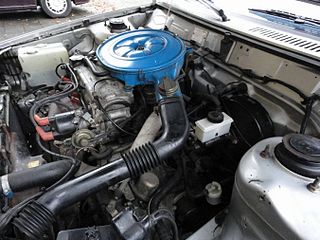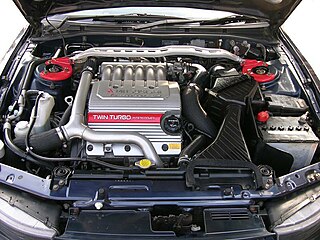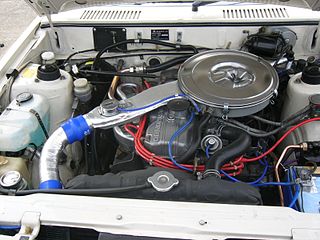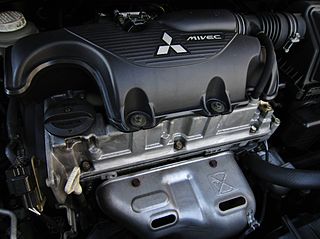
The Mitsubishi Eclipse is a sport compact car that was produced by Mitsubishi in four generations from 1989 until 2011. A convertible body style was added during the 1996 model year.

The Mitsubishi 3000GT is a front-engine, all-wheel/front-wheel drive grand touring/sports car manufactured and marketed by Mitsubishi from 1990 until 2000 over three different series. Manufactured in a three-door hatchback coupé body style in Nagoya, Japan, the 2+2 four-seaters were marketed in the Japanese domestic market as the GTO, and globally as 3000GT. In North America, it was sold both as the Mitsubishi 3000GT (1991–1999) and the Dodge Stealth (1991–1996), a badge engineered, mechanically identical captive import. As a collaborative effort between Chrysler and Mitsubishi Motors, Chrysler was responsible for the Stealth's exterior styling.

The Chrysler 1.8, 2.0, and 2.4 are inline-4 engines designed originally for the Dodge and Plymouth Neon compact car. These engines were loosely based on their predecessors, the Chrysler 2.2 & 2.5 engine, sharing the same 87.5 mm (3.44 in) bore. The engine was developed by Chrysler with input from the Chrysler-Lamborghini team that developed the Chrysler/Lamborghini Formula 1 V12 engine in the early 1990s.

The F engine family from Mazda is a mid-sized inline-four piston engine with iron block, alloy head and belt-driven SOHC and DOHC configurations. Introduced in 1983 as the 1.6-litre F6, this engine was found in the Mazda B-Series truck and Mazda G platform models such as Mazda 626/Capella as well as many other models internationally including Mazda Bongo and Ford Freda clone, Mazda B-series based Ford Courier, Mazda 929 HC and the GD platform-based Ford Probe

The Mitsubishi 6A1 engine is a series of piston V6 engines from Mitsubishi Motors, found in their small and medium vehicles through the 1990s. They ranged from 1.6 to 2.5 L in size, and came with a variety of induction methods and cylinder head designs and configurations.

The Mitsubishi Astron or 4G5/4D5 engine, is a series of straight-four internal combustion engines first built by Mitsubishi Motors in 1972. Engine displacement ranged from 1.8 to 2.6 litres, making it one of the largest four-cylinder engines of its time.

The Mitsubishi Sirius or 4G6/4D6 engine is the name of one of Mitsubishi Motors' four series of inline-four automobile engines, along with Astron, Orion, and Saturn.

The Mitsubishi Orion or 4G1 engine is a series of inline-four internal combustion engines introduced by Mitsubishi Motors in around 1977, along with the Astron, Sirius, and Saturn. It was first introduced in the Colt and Colt-derived models in 1978. Displacement ranges from 1.2 to 1.6 L.

The Mitsubishi Saturn or 4G3 engine is series of overhead camshaft (OHC) straight-four internal combustion engines introduced by Mitsubishi Motors and saw first service in the 1969 Colt Galant. Displacement ranges from 1.2 to 1.8 L, although there was also a rare 2-litre (1,994 cc) inline-six version built from 1970 until 1976. The early versions have chain driven valvetrain while the later versions are belt driven and equipped with balance shafts.

The Mitsubishi 4G9 engine is a series of straight-4 automobile engines produced by Mitsubishi Motors. All are 16-valve, and use both single- and double- overhead camshaft heads. Some feature MIVEC variable valve timing, and it was the first modern gasoline direct injection engine upon its introduction in August 1996.
The Hyundai Sigma engine is what Hyundai Motor Company called the Mitsubishi 6G7 engine when manufactured in South Korea. It is a series of V6 piston engines. The Sigma engine family began life with the simple V6 name. Displacement ranges from 2.5 to 3.5 L.

The Honda D series inline-four cylinder engine is used in a variety of compact models, most commonly the Honda Civic, CRX, Logo, Stream, and first-generation Integra. Engine displacement ranges between 1.2 and 1.7 liters. The D Series engine is either SOHC or DOHC, and might include VTEC variable valve lift. Power ranges from 66 PS (49 kW) in the Logo to 130 PS (96 kW) in the Civic Si. D-series production commenced in 1984 and ended in 2005. D-series engine technology culminated with production of the D15B 3-stage VTEC (D15Z7) which was available in markets outside of the United States. Earlier versions of this engine also used a single port fuel injection system Honda called PGM-CARB, signifying the carburetor was computer controlled.

The single overhead cam V6 engine introduced in 1993. It was derived from Chrysler's first homegrown front-wheel drive V6, the Chrysler 3.3 engine. The SOHC V6 has been replaced by the Chrysler Pentastar engine.

The Mitsubishi Galant VR-4 was the range-topping version of Mitsubishi Motors' Galant model, available in the sixth (1987–1992), seventh (1992–1996) and eighth (1996–2002) generations of the vehicle. Originally introduced to comply with the new Group A regulations of the World Rally Championship, it was soon superseded as Mitsubishi's competition vehicle by the Lancer Evolution, and subsequently developed into a high-performance showcase of the company's technology.

The Mitsubishi 3G8 engine is a range of three-cylinder powerplant from Mitsubishi Motors, introduced in the fifth generation of their Mitsubishi Minica kei car. In common with other contemporary engines in the class, it could be specified with many advanced technologies despite its diminutive size, including multi-valve cylinder heads and double overhead camshafts. The top-of-the-line Dangan ZZ variant was also the first kei car to benefit from turbocharging. In 1987 Mitsubishi was the first manufacturer to supercharge a kei vehicle, and in 1989 became the world's first production car to feature five valves per cylinder, ahead of similar developments by Bugatti, Audi, Ferrari and Toyota.

The Mitsubishi 4A3 engine is a range of alloy-headed inline four-cylinder engines from Mitsubishi Motors, introduced in 1993 in the sixth generation of their Mitsubishi Minica kei car. It shares a 72 mm (2.8 in) bore pitch with the 3G8-series three-cylinder engines, but has a considerably shorter stroke so as to stay beneath the 660 cc limit imposed by the Kei class.

The Mitsubishi 4A9 engine is the newest family range of all-alloy inline four-cylinder engines from Mitsubishi Motors, introduced in the 2004 version of their Mitsubishi Colt supermini, and built by DaimlerChrysler-owned MDC Power in Germany.

The Mitsubishi 4B1 engine is a range of all-alloy straight-4 piston engines built at Mitsubishi's Japanese "World Engine" powertrain plant in Shiga on the basis of the Global Engine Manufacturing Alliance (GEMA). Although the basic designs of the various engines are the same, their exact specifications are individually tailored for each partner. The cylinder block and other basic structural parts of the engine were jointly developed by the GEMA companies, but the intake and exhaust manifolds, the cylinder head's intake and exhaust ports, and other elements related to engine tuning were independently developed by Mitsubishi.

The Mitsubishi 6B3 engine is a range of all-alloy piston V6 engines developed by Mitsubishi Motors. Currently, only one engine has been developed, a 3.0 L (2,998 cc) V6 first introduced in the North American version of the second generation Mitsubishi Outlander which debuted in October 2006.


















